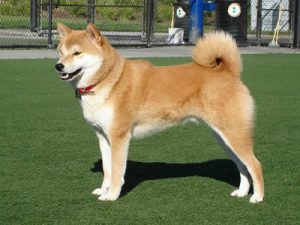
The Shiba Inu is the smallest of the six original and distinct breeds of dog from Japan.
A small, agile dog that copes very well with mountainous terrain, the Shiba Inu was originally bred for hunting. It is similar in appearance to the Akita, though much smaller in stature.
Appearance
The Shiba’s frame is compact with well-developed muscles. Males and females are distinctly different in appearance: males are masculine without coarseness, females are feminine without weakness of structure. Males 14 1/2 inches to 16 1/2 inches (35–43 cm) at withers. Females 13 1/2 inches to 15 1/2 inches (33–41 cm). The preferred size is the middle of the range for each sex. Average weight at preferred size is approximately 23 pounds (10 kg) for males, 17 pounds (8 kg) for females. Bone is moderate.
Coat: Double coated with the outer coat being stiff and straight and the undercoat soft and thick. Fur is short and even on face, ears, and legs. Guard hairs stand off the body are about 1 1/2 to 2 inches in length at the withers. Tail hair is slightly longer and stands open in a brush. Shibas may be red, black and tan, or sesame (red with black-tipped hairs), with a cream, buff, or grey undercoat. They may also be cream, though this colour is a major fault and should never be intentionally bred, as the required markings known as “urajiro” are not visible. “Urajiro” literally translates to “underside white” are unable to be seen. The urajiro (cream to white ventral colour) is required in the following areas on all coat colours: on the sides of the muzzle, on the cheeks, inside the ears, on the underjaw and upper throat inside of legs, on the abdomen, around the vent and the ventral side of the tail. On reds: commonly on the throat, forechest, and chest. On blacks and sesames: commonly as a triangular mark on both sides of the forechest.
Temperament
Shiba Inus are generally independent and intelligent dogs. Some owners struggle with obedience training, but as with many dogs, socialisation at a young age can greatly affect temperament. Traits such as independence and intelligence are often associated with ancient dog breeds, such as the Shiba Inu. Shibas should always be on a leash, unless in a secured area because of their strong prey drive.
From the Japanese breed standard:
A spirited boldness, a good nature, and an unaffected forthrightness, which together yield dignity and natural beauty. The Shiba has an independent nature and can be reserved toward strangers but is loyal and affectionate to those who earn his respect. They can be aggressive toward other dogs sometimes.
The terms “spirited boldness”, “good nature”, and “artlessness” have subtle interpretations that have been the subject of much commentary.
The Shiba is a fastidious breed and feels the need to maintain itself in a clean state. They can often be seen licking their paws and legs much like a cat. They generally go out of their way to keep their coats clean, and while walking will avoid stepping in puddles, mud and dirt. Because of their fastidious nature, the Shiba puppy is easy to housebreak and in many cases will housebreak themselves. Having their owner simply place them outside after meal times and naps is generally enough to teach the Shiba the appropriate method of toileting.
A distinguishing characteristic of the breed is the so-called “shiba scream”. When sufficiently provoked or unhappy, the dog will produce a loud, high pitched scream. This can occur when attempting to handle the dog in a way that it deems unacceptable. The animal may also emit a very similar sound during periods of great joy, such as the return of the owner after an extended absence, or the arrival of a favoured human guest.
—————————————————————————————————————–
CARING FOR YOUR DOG NEWSLETTER – Delivered Directly To Your Inbox – Starting Immediately – SIGN UP FOR FREE TODAY
—————————————————————————————————————–
